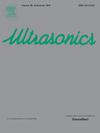Zero-frequency wave based-SAFT imaging for high-density polyethylene with irregular surfaces
IF 4.1
2区 物理与天体物理
Q1 ACOUSTICS
引用次数: 0
Abstract
When an ultrasound tone-burst propagates in an elastic solid with quadratic nonlinearities, a pulse wave with a carrier frequency of zero (referred to as zero-frequency wave, ZFW) will be generated due to material nonlinearity. The low acoustic attenuation characteristics of ZFW is particularly well-suited for defect detection of highly attenuative materials. In our previous study, large detection depths in high-density polyethylene (HDPE) have been demonstrated using ZFW. However, in practical engineering applications, defect detection in HDPE with irregular surfaces is hindered by limitations in complex propagation path and low coupling efficiency. To address this issue, using ZFWs generated by the propagation of high-frequency ultrasonic waves, a water immersion SAFT imaging method is proposed for HDPE with irregular surfaces. The proposed method, based on the priori knowledge of geometric interface between water and the measured HDPE with irregular surface, utilizes the Snell’s law to get the propagation paths of the ZFWs. The propagation time of ZFW in water and HDPE is computed using these paths, through which its time-of-flight is obtained. The time-of-flight is subsequently utilized to calculate the intensity of each pixel. Finally, the normalized imaging results are finally generated after iterative computations across all scanning points. Experimental results show that the proposed method is capable of detecting side-drilled hole defects with a diameter of 1 mm and a longitudinal depth of approximately 100 mm in HDPE with irregular surfaces including incline surface, convex surface, and concave surface. These findings validate the effectiveness of the proposed method in detecting defects in highly attenuative materials with irregular surface, demonstrating its potential as a valuable tool for non-destructive testing.
基于零频率波的不规则表面高密度聚乙烯saft成像
超声声爆在具有二次非线性的弹性固体中传播时,由于材料非线性,会产生载频为零的脉冲波(简称零频波,ZFW)。ZFW的低声衰减特性特别适合于高衰减材料的缺陷检测。在我们之前的研究中,使用ZFW已经证明了高密度聚乙烯(HDPE)的大检测深度。然而,在实际工程应用中,受复杂传播路径和低耦合效率的限制,具有不规则表面的HDPE缺陷检测受到阻碍。为了解决这一问题,利用高频超声波传播产生的ZFWs,提出了一种针对具有不规则表面的HDPE的水浸SAFT成像方法。该方法基于水与被测HDPE表面不规则的几何界面的先验知识,利用Snell定律得到ZFWs的传播路径。利用这些路径计算了ZFW在水中和HDPE中的传播时间,从而得到了ZFW的飞行时间。随后利用飞行时间计算每个像素的强度。最后,经过各扫描点的迭代计算,最终得到归一化的成像结果。实验结果表明,该方法能够检测出具有斜面、凸面和凹面等不规则表面的HDPE中直径为1 mm、纵向深度约为100 mm的侧钻孔缺陷。这些发现验证了所提出的方法在检测具有不规则表面的高衰减材料缺陷方面的有效性,证明了它作为一种有价值的无损检测工具的潜力。
本文章由计算机程序翻译,如有差异,请以英文原文为准。
求助全文
约1分钟内获得全文
求助全文
来源期刊

Ultrasonics
医学-核医学
CiteScore
7.60
自引率
19.00%
发文量
186
审稿时长
3.9 months
期刊介绍:
Ultrasonics is the only internationally established journal which covers the entire field of ultrasound research and technology and all its many applications. Ultrasonics contains a variety of sections to keep readers fully informed and up-to-date on the whole spectrum of research and development throughout the world. Ultrasonics publishes papers of exceptional quality and of relevance to both academia and industry. Manuscripts in which ultrasonics is a central issue and not simply an incidental tool or minor issue, are welcomed.
As well as top quality original research papers and review articles by world renowned experts, Ultrasonics also regularly features short communications, a calendar of forthcoming events and special issues dedicated to topical subjects.
 求助内容:
求助内容: 应助结果提醒方式:
应助结果提醒方式:


